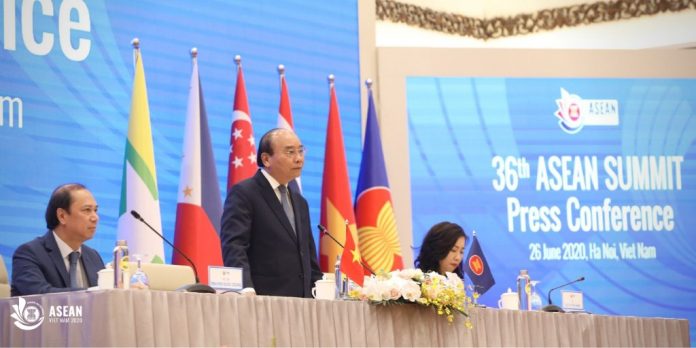The ASEAN (Association of South East Asian Nations) Summit 2020 was held online on June 26, 2020. Vietnam is the ASEAN Chair for this year. The timing of the summit was significant not just in the context of ASEAN region, given the fact that South East Asia is grappling with complex economic and geopolitical challenges, but was significant in the context of the ‘Indo-Pacific’ region as a whole.
Firstly, the summit was held in the midst of the coronavirus pandemic. A number of ASEAN countries, including Vietnam, Thailand, Cambodia and Myanmar have been successful in checking the spread of the virus. In South Asia, however, especially India, the number of cases are steadily rising.
Second, the summit was held weeks after tensions between Vietnam and China (in April 2020, a Chinese coast guard ship sank a Vietnamese Fishing boat, and even Manila which under the leadership of Rodrigo Duterte has veered towards China, was unequivocal in criticizing China’s aggression). The summit was also held in the midst of rising tensions between Beijing and New Delhi along the Line of Actual Control ( LAC) in Ladakh (20 Indian soldiers of the Bihar regiment including the Commanding officer, were brutally killed by the People’s Liberation Army, PLA, on June 15, 2020 in the Galwan Valley).
New Delhi and Beijing have been seeking to reduce tensions but analysts believe that strains between both countries are only likely to increase. The U.S. Secretary of State Mike Pompeo has repeatedly referred to China’s aggressive behavior in Asia. On June 25, 2020 Pompeo in a virtual address, stated that Washington was moving some of its troops from Europe to Asia to confront the mounting threat from China.
The focus of the Summit: Covid-19 and beyond
One of the main thrusts of the ASEAN summit was to work jointly towards getting the economies of member states which have suffered immensely as a result of the pandemic, back on the rails.
According to forecasts, most ASEAN nations are likely to face a serious recession. Vietnam has witnessed growth of 0.36 percent during the period from April-June 2020 (the economy had begun to open up in the end of April but after effects of the strict lockdown were still there). According to IMF estimates, Vietnam’s economy may grow at 2.7 percent in 2020, way below the targeted 7 percent but remarkable given the global turmoil. The other economy which if fortunate may grow at 0.5 percent is Myanmar, though these are optimistic predictions. Economies of Malaysia, Singapore, Indonesia and the Phillipines are likely to contract severely. One of the important points which was discussed was the resumption of connectivity, including air connectivity, between ASEAN states.
The Vietnamese PM, Nguyen Xuan Phuc made a reference to China’s aggression in South China Sea in April. He said, “…there were irresponsible acts, violating international laws, that affected the security and stability of some regions including ours.”
A statement issued by the ASEAN Chair also alluded to China’s aggression, and stated that UNCLOS 1982 should govern sovereign rights in the South China Sea. He further referred to the the dire need for implementation of the 2002 Declaration on the Conduct of Parties in the South China Sea (DOC).
New Delhi’s reactions to the ASEAN Summit
New Delhi, whose ties with Beijing have hit rock bottom in recent weeks, would be closely watching the references to China’s aggressive behaviour vis-à-vis ASEAN neighbours. As mentioned earlier, the Trump Administration has made repeated references to Chinese belligerence. If one were to look at some of the steps being taken, apart from shifting of troops, the NDAA (National Defence Authorization Act) for fiscal 2021 has sought fighter jet training detachment in Guam.
India’s ties with ASEAN
While on the one hand, as a result of China’s recent belligerence, the strategic relationship between India and ASEAN countries which has burgeoned in the past two decades, is likely to gain more momentum. At the ASEAN virtual summit, all member states spoke about the need for going ahead with the Regional Comprehensive Economic Partnership (RCEP) agreement which includes ASEAN member states, Australia, China, Japan, South Korea and New Zealand.
Given the tensions across the LAC, there is not much scope for India being part of the RCEP (India has already conveyed its inability to be part of the agreement due to unfavorable terms), especially at a time when there is a growing chorus for downgrading economic ties with China. A number of steps have been taken by the government to reduce economic dependence upon China, including the banning of 59 apps originating from China, and there is a growing chorus for boycott of Chinese goods.
When the RCEP’s Trade Negotiating Committee (TNC) Chairperson in a letter to the Indian government in May 2020, made an offer that it was willing to examine India’s objections if it rejoined the grouping, India responded by stating that it was seeking to reduce dependence upon China, and joining the RCEP would not help in achieving this goal, and also hamper India’s attempts at bolstering domestic manufacturing. It would be pertinent to point out, that countries like Japan and Australia have been urging India to join the RCEP.
A meeting of 15 member states of RCEP had issued a statement urging India to rejoin the grouping. Some Indian commentators have also been arguing in favor of India being part of the RCEP arguing that it would benefit India economically.
The ASEAN Summit sends a clear message that China’s increased belligerence and expansionist designs in Asia will give a further fillip to strategic cooperation between India and other countries in Asia. However, on economic issues, there are likely to be differences (given the level of dependence upon China) and New Delhi needs to adopt a pragmatic approach. New Delhi also needs to bear in mind that a more robust economy will give it more room for manoeuvre in terms of foreign policy.
The views and opinions expressed in this article are those of the author.

Tridivesh Singh Maini is a New Delhi based analyst interested in Punjab-Punjab linkages as well as Partition Studies. Maini co-authored ‘Humanity Amidst Insanity: Hope During and After the Indo-Pak Partition’ (New Delhi: UBSPD, 2008) with Tahir Malik and Ali Farooq Malik. He can be reached at [email protected].


